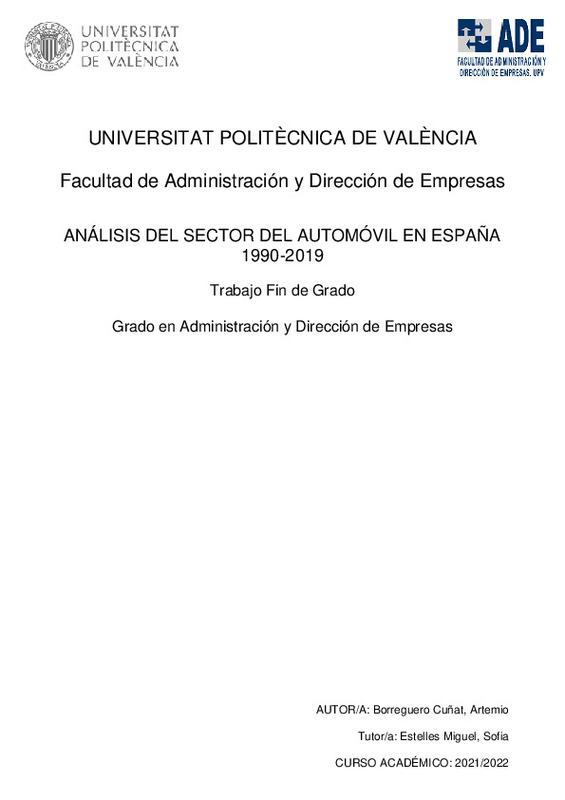JavaScript is disabled for your browser. Some features of this site may not work without it.
Buscar en RiuNet
Listar
Mi cuenta
Estadísticas
Ayuda RiuNet
Admin. UPV
Análisis del sector del automóvil en España 1990-2019
Mostrar el registro sencillo del ítem
Ficheros en el ítem
| dc.contributor.advisor | Estelles Miguel, Sofia
|
es_ES |
| dc.contributor.author | Borreguero Cuñat, Artemio
|
es_ES |
| dc.date.accessioned | 2022-09-12T13:48:34Z | |
| dc.date.available | 2022-09-12T13:48:34Z | |
| dc.date.created | 2022-07-25 | |
| dc.date.issued | 2022-09-12 | es_ES |
| dc.identifier.uri | http://hdl.handle.net/10251/185835 | |
| dc.description.abstract | [ES] El objetivo general de este trabajo es analizar el sector automovilístico en España, desde 1990 hasta 2019. La metodología utilizada fue un análisis descriptivo cualitativo del periodo 1990 a 2019. Se realizó una descripción de las actividades que forman parte del sector automovilístico y una descripción general del sector automovilístico en España. Además, se realizó un análisis PESTEL, un análisis de las 5 Fuerzas de Porter y un análisis DAFO. Por último, se analizaron las perspectivas a futuro del sector. Entre los resultados se encontró que las principales actividades que forman parte del sector automovilístico en España son la fabricación de vehículos de motor y la fabricación de componentes, piezas y accesorios para vehículos de motor. El sector automovilístico en España contaba con 17 plantas de fabricación de vehículos en el territorio español en 2019. Las cifras macroeconómicas y microeconómicas muestran que España era en 2019 el 2º productor de vehículos en Europa, siendo el 1º en vehículos industriales, y 8º a nivel mundial. Debido a la crisis de 2008, las ventas de vehículos cayeron significativamente, estas dependían positivamente de la renta nacional neta y negativamente del tipo de interés hasta el año 2008, a partir del 2008 dependían positivamente del precio del petróleo. El sector automovilístico aportaba el 10% del PIB al país en el año 2019. La producción anual de vehículos entre el periodo 1990 a 2019 se mantuvo en más de 2,6 millones de unidades fabricadas al año. El aumento de la demanda del sector automovilístico se recuperó gracias al aumento de la demanda interna, impulsada por los planes de incentivo. Los retos a futuro se enfocan en el impulso del uso de energías limpias y la inversión en tecnología, I+D y revolucionar el concepto tradicional de automóvil. | es_ES |
| dc.description.abstract | [EN] The general objective of this work is to analyze the impact of the automobile sector on the economy at a national level in Spain. The methodology used was a qualitative descriptive analysis of the period 1990 to 2019. A description of the activities that are part of the automotive sector and a general description of the automotive sector in Spain were made. In addition, a PESTEL analysis, a Porter's 5 Forces analysis and a SWOT analysis were performed. Finally, the future prospects of the sector were analyzed. Among the results, it was found that the main activities that are part of the automotive sector in Spain are the manufacture of motor vehicles and the manufacture of components, parts and accessories for motor vehicles. The automotive sector in Spain had 17 vehicle manufacturing plants in the Spanish territory in 2019. The macroeconomic and microeconomic figures show that Spain was the 2nd producer of vehicles in Europe in 2019, being the 1st in industrial vehicles, and 8th in world level. Due to the 2008 crisis, vehicle sales fell significantly, they depended positively on the net national income and negatively on the interest rate until 2008, from 2008 they depended positively on the price of oil. The automotive sector contributed 10% of the GDP to the country in 2019. The annual production of vehicles between the period 1990 to 2019 remained at more than 2.6 million units manufactured per year. The increase in demand in the automotive sector recovered thanks to the increase in domestic demand, driven by incentive plans. Future challenges focus on promoting the use of clean energy and investment in technology, R&D and revolutionizing the traditional concept of the automobile. | es_ES |
| dc.format.extent | 69 | es_ES |
| dc.language | Español | es_ES |
| dc.publisher | Universitat Politècnica de València | es_ES |
| dc.rights | Reserva de todos los derechos | es_ES |
| dc.subject | Sector automovilístico | es_ES |
| dc.subject | Spain | es_ES |
| dc.subject | Automóvil | es_ES |
| dc.subject | Automoción | es_ES |
| dc.subject | España | es_ES |
| dc.subject | Automobile | es_ES |
| dc.subject | Automotive Industry | es_ES |
| dc.subject.classification | ORGANIZACION DE EMPRESAS | es_ES |
| dc.subject.other | Grado en Administración y Dirección de Empresas-Grau en Administració i Direcció d'Empreses | es_ES |
| dc.title | Análisis del sector del automóvil en España 1990-2019 | es_ES |
| dc.title.alternative | Analysis of the automobile sector in Spain 1990-2019 | es_ES |
| dc.title.alternative | Anàlisi del sector de l'automóbil a Espanya 1990-2019 | es_ES |
| dc.type | Proyecto/Trabajo fin de carrera/grado | es_ES |
| dc.rights.accessRights | Abierto | es_ES |
| dc.contributor.affiliation | Universitat Politècnica de València. Departamento de Organización de Empresas - Departament d'Organització d'Empreses | es_ES |
| dc.contributor.affiliation | Universitat Politècnica de València. Facultad de Administración y Dirección de Empresas - Facultat d'Administració i Direcció d'Empreses | es_ES |
| dc.description.bibliographicCitation | Borreguero Cuñat, A. (2022). Análisis del sector del automóvil en España 1990-2019. Universitat Politècnica de València. http://hdl.handle.net/10251/185835 | es_ES |
| dc.description.accrualMethod | TFGM | es_ES |
| dc.relation.pasarela | TFGM\148522 | es_ES |
Este ítem aparece en la(s) siguiente(s) colección(ones)
-
ADE - Trabajos académicos [3699]
Facultad de Administración y Dirección de Empresas






